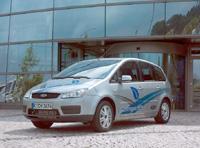Another Great Opportunity Blown! POWERED BY HYDROGEN: LOOKING TO THE FUTURE WITH THE FORD FOCUS C-MAX H2 INTERNAL COMBUSTION ENGINE
 |
STUTTGART, July 13, 2004 – Ford engineers have equipped the Ford Focus C-MAX with a prototype hydrogen internal combustion engine (H 2 ICE). The vehicle was unveiled today at the Research Conference of the German Car Manufacturer Association (VDA) in Stuttgart, which was attended by the German Chancellor Gerhard Schröder and other important political figures.
The Ford Research Center at Aachen (FFA) has developed this technology demonstrator to analyse its technical and environmental potential. On the way towards achieving sustainable mobility, Ford regards the hydrogen internal combustion engine as an important step towards a hydrogen-fuelled future where fuel cells delivering clean electric power is the ultimate goal.
Before the technical and economical maturity of fuel cell vehicles is achieved, it is important to establish a commercial demand for hydrogen fuel. This will help to establish a hydrogen fuelling infrastructure and, as more vehicles need hydrogen, so this network of fuelling stations will grow.
It is likely that the commercial viability of the hydrogen-fuelled internal combustion engine will be established earlier than the fuel cell, since the appeal of this type of engine has developed over a period of more than 100 years.
However, this does not mean that the modifications required to produce the prototype hydrogen internal combustion engine are trivial. The base engine is a 2.3 litre four-cylinder gasoline engine producing 110 hp (82kW). The Ford Focus C-MAX with H 2 ICE differs from the base vehicle mainly in the packaging of the engine. The battery has been moved from the engine compartment to underneath the back seat; additionally, there are special safety systems and sensors to suit the different fuel tank technology. The H 2 ICE power train also requires some additional electronic systems and components such as two intercoolers.
The test vehicle uses compressed gaseous hydrogen stored at 350 bar in three tanks. Two are located in the trunk and the third one is installed underfloor. Two pressure regulators reduce the gas pressure down to 5.5 bar at the engine manifold. Altogether the three tanks accommodate a capacity of 119 litres, which equates to 2.75 kg of hydrogen and provides a range of about 200 km.
A supercharger enables the Ford Focus C-MAX H 2 ICE to have similar performance to the corresponding gasoline engine. By compressing the intake air, the supercharger increases the mass of the fuel mixture in the combustion chamber. During compression the air is heated and it is then cooled by the two intercoolers, of which one is located behind the front bumper and the other in the middle of the engine compartment. The cooled and compressed air is fed to the combustion engine to combine with the hydrogen in the cylinders.
The hydrogen/air-ratio of the Ford Focus C-MAX H 2 ICE can be adjusted in a wide range since the ignitability of hydrogen in air varies from four to 70 per cent by volume. This means that both very lean and very rich hydrogen/air mixtures are possible, which enables the optimal control of fuel consumption and NO x emissions to be achieved.
Another important project leading towards a sustainable hydrogen-based future is the Clean Energy Partnership (CEP) in Berlin which is funded by the German Government. Ford is one of the nine different industry partners which participate in the three-year-project. In the framework of the CEP, Ford will provide three fuel cell vehicles for fleet customers.
The objective of the CEP is to prove the suitability of the mobile application of hydrogen for everyday use. Hydrogen is considered as an environmentally friendly energy source since it can be generated from solar, wind and water, i.e. renewable energy sources. Compared with the hydrogen ICE, the fuel cell achieves higher efficiency and it does not emit any greenhouse or other exhaust gases.


